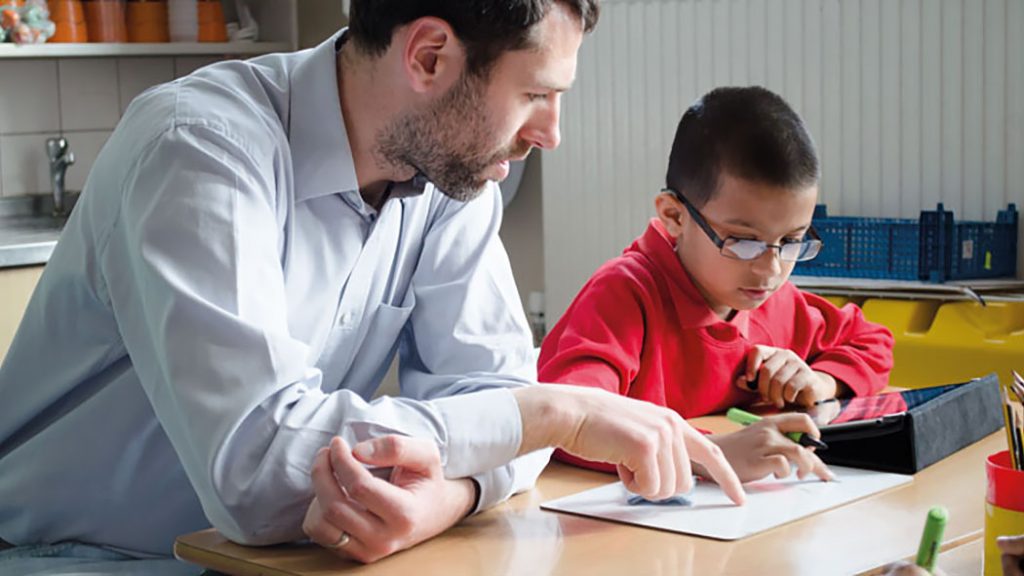January 23, 2024
When you think of an expert—whether it’s a musician, an athlete, or a chef—the common denominator for their success is most certainly the amount of practice they put in. When it comes to reading, the same holds true: Students who read more are better readers.
But we don’t just learn to read as part of human development; reading is not a natural process that will happen on its own. Learning to read requires an enormous amount of explicit and systematic instruction, provided over many years, with a lot of practice.
So, how can we help students to make the most of reading practice? In this blog, we’ll offer three key takeaways from research, along with practical examples to consider in your school or district.
What do we mean by “purposeful practice”?
The key to powerful reading practice is that it must be purposeful. Purposeful practice is goal-oriented, meaning that students practice the right skills at the right time. In addition, purposeful practice:
- Is aligned to classroom instruction
- Adapts to student need
- Includes immediate and corrective feedback, to ensure students are practicing correctly before they begin to practice independently
Practice is often an afterthought in many classrooms, which is not surprising when you consider how much effort needs to go into planning and delivering reading instruction. However, instruction is just the first step in ensuring students will learn something. Practice is what makes it “stick.”
Having said that, we need to acknowledge that not all practice is created equal or for the same purpose. Just as learning occurs in phases, so does practice (VanDerHeyden & Burns, 2023). Practice moves from the acquisition of a specific skill to fluency of that skill, and finally onto the generalization or application of that skill to new material.
Knowing what makes good practice and the different purposes for practice will assist us in choosing the right kind of practice. Now, let’s consider the three most important takeaways when it comes to purposeful practice.

Why individualized skills practice is essential for skill acquisition
Readers do not become proficient simply by reading books, just as musicians do not become experts simply by playing in a band, or athletes by playing on a team, or chefs by working in a restaurant. A lot of work and practice must happen on individual skills before you can apply those skills into a context.
To use another analogy, think of building a house. Clearly, it must have a strong foundation that can support additional levels—and, eventually, the roof—in order to be complete. Similarly, readers must receive explicit instruction and practice on foundational skills like phonological awareness, phonics, and vocabulary so that they can then apply these skills while comprehending and applying what they are learning.
So, our first takeaway is that individualized skills practice is essential for students as they acquire new literacy skills. It is an efficient way to ensure students learn foundational skills to a high degree of accuracy. Moreover, individualized skills practice:
- Reinforces skills being taught in the curriculum.
- Follows a logical scope and sequence aligned to assessment data or teacher selection.
- Scaffolds skills and adapts to student performance.
- Provides opportunities for immediate and formative feedback.
Individualized skills practice: From acquisition to fluency
Here’s a tangible example of individualized skills practice, using the foundational skill of phonics. When first teaching students how to decode simple consonant-vowel-consonant (CVC) words like /cat/, it’s important to follow up the instruction with many opportunities to practice this skill that mirror the instruction.
In this scenario, the teacher should provide explicit and systematic instruction using the “I do, we do, you do” framework:
- “I do” means the teacher shows, demonstrates, and produces the exact response she wants the students to carry out—in this case, decoding the word “cat”. The goal is to leave nothing to chance, and to avoid the students learning it incorrectly and then having to relearn it.
- “We do” means the teacher continues the lesson but asks the students to respond with her.
- “You do” means the students produce the sound by themselves.
Practice is then implemented to mirror the instruction. The more accurate the students are, the more time they can spend on independent practice, where the focus moves from the acquisition of skills to the fluency of skills.
This brings us to our second takeaway.
Solutions for purposeful practice
Explore Renaissance literacy solutions that drive more purposeful literacy practice at every grade level.
How dynamic reading practice supports fluency and generalization
Once the foundation is laid and students have acquired basic reading skills, it’s time to build the next levels of our literacy “house.” These are fluency and comprehension.
Dynamic reading practice assists in moving students from the acquisition of basic skills to practicing these skills in ways that support their continued reading growth. Students benefit from increased practice in connected text, which requires less support and builds fluency and generalization of skills.
However, just because students can read text does not mean they will practice. Therefore, there are some key features of dynamic reading practice that are important to call out. Dynamic reading is inclusive of:
- Access to a wide variety of texts across topics that are meaningful to the student.
- Texts covering various interests, subjects, and genres—and available in additional languages for bilingual learners.
- Alignment of practice to standards by including interactive tools, such as highlighting and note taking.
- Feedback to encourage students’ progress and build reading stamina.
Dynamic reading practice using a wide variety of texts
When aiming to support the fluency of specific skills, it’s important to follow up instruction with many opportunities for students to practice across different types of text. Here’s what this might look like:
- When teaching specific phonics patterns, practice often starts with decodables to ensure the student is successful, before moving on to less controlled text.
- As the student demonstrates success (they are accurate, quick, and use proper expression when reading), additional and varied types of text should be used. This may include reading poems, plays, and other types of text if the focus is on expression, and reading longer text if the focus is on stamina and speed.
- Students are not left entirely on their own when practicing fluency. Teachers should be listening to their students read aloud periodically, to provide feedback as well as encouragement.
We cannot ignore the key role of vocabulary and meaning in this process. The more times a student is exposed to a word, the more likely they will learn that word and it will become part of their lexicon. This means that when they encounter that word, they’ll be able to quickly derive meaning from it and generalize and adapt to learning new words and information.
For this reason, vocabulary instruction must be followed up with many opportunities to practice reading across a wide range of texts. It takes a vocabulary of around 50,000 words to be able to understand a new language (Vaughn & Fletcher, 2023). For students to learn 50,000 words, much of that learning must occur without direct instruction but rather through wide, dynamic reading.

Dynamic reading practice, vocabulary, and Emerging Bilinguals
While vocabulary instruction is critical for all students, it is especially important for Emerging Bilingual students, or Multilingual Learners. Emerging Bilingual students need exposure to multiple strategies that support the formation of necessary background knowledge, as well as intentional vocabulary instruction rooted in meaning and context (Ebe, 2010; Baker et al., 2014).
Knowing that reading itself is a dynamic process, Emerging Bilingual students need access to a wide variety of culturally relevant texts that provide the opportunity for exposure to new and repeated vocabulary within meaningful contexts. Additionally, supporting students in the fluency of their home languages and family literacy practices supports both the acquisition of an additional language and the connections between languages, further supporting literacy development.
Why practice must be repeated and spaced over time
Just as instruction cannot be delivered only once with the expectation that students will instantly learn it, practice needs to be repeated as well as spaced over time for students to truly benefit from it.
In fact, to learn a new skill, students require multiple repetitions—between 6 and 20—when learning new material like letter/sounds patterns (i.e., new words) or the meanings of words (Rott, 1999; Waring & Takaki, 2003). Some of these repetitions occur through direct instruction and some occur through purposeful practice activities.
Here’s a tangible example of the power of repetition: Students learning to read words with r-controlled vowels (e.g., car, star, chair, bear) may need up to 20 opportunities to practice the word before it becomes a sight word, meaning the student can retrieve it instantaneously from long term memory, as opposed to sounding it out.
However, this does not mean you should have the student practice reading r-controlled vowels 20 times in one day. Practice should be repeated over multiple days and weeks to ensure the skill is learned beyond working memory. This is our third takeaway.
Purposeful practice, repetition, and retrieval
For literacy skills students need to learn and retain longer because they are prerequisites for additional learning, the longer the period of time that skill should be practiced. Bunching up the practice to occur all within a day or even a week is not as effective as spacing it out over multiple weeks to allow students the opportunity to retrieve information from long-term memory.
Research indicates that distributing practice over time improves remembering because the time in between allows time for the student to forget (Carpenter et al., 2012). Yes, you read that correctly: Forgetting helps us to remember! This is because when we retrieve something we just learned from rote, we don’t have to work very hard.
Instead, if we let some time go by between when we learned it and when we have to retrieve it, we have to work harder to remember it. The more we practice activating our long-term memory, the more solidified the information becomes, making it easier to retrieve each time we practice.

How Renaissance supports purposeful practice for literacy
To sum up, research provides the following key takeaways about purposeful practice:
- Individualized skills practice is necessary for the acquisition of a new literacy skill.
- Dynamic reading practice is needed to support fluency and generalization.
- Practice must be repeated and spaced over time.
While the research is clear about what is needed to ensure that all learners receive the right amount and right kind of practice opportunities, implementing purposeful practice in the classroom can be daunting. This is why Renaissance offers a flexible pre-K–12 literacy practice solution that includes:
- Lalilo and Freckle for individualized skills practice that adapts to each student’s level, is driven by assessment, and follows a structured scope and sequence. Lalilo focuses on learners who are just starting to develop foundational skills. Freckle’s strength is in supporting students who already read independently and are now reading to learn.
- myON and Accelerated Reader for dynamic reading practice that allows students to explore and engage with texts in meaningful ways. myON gives students access to thousands of books, in English and additional languages, to anchor learning and literacy development in students’ interest areas and in different genres. Accelerated Reader allows students to monitor their reading comprehension over time, ensuring they can put all of their literacy skills together to make meaning.
Together, these tools help you to provide all of your learners with the ongoing, purposeful practice they need to become confident and proficient lifelong readers.
References
Baker, S., Lesaux, N., Jayanthi, M., Dimino, J., Proctor, C., Morris, J., Gersten, R., Haymond, K., Kieffer, M., Linan-Thompson, S., & Newman-Gonchar, R. (2014). Teaching academic content and literacy to English learners in elementary and middle school (NCEE 2014-4012). Washington, DC: National Center for Education Evaluation and Regional Assistance (NCEE), Institute of Education Sciences, US Department of Education.
Carpenter, S., Cepeda, N., Rohrer, D., Kang, S., & Pashler, H. (2012). Using spacing to enhance diverse forms of learning: Review of recent research and implications for instruction. Educational Psychology Review, 24, 369–378.
Ebe, A. (2010). Culturally relevant texts and reading assessment for English Language Learners. Reading Horizons: A Journal of Literacy and Language Arts, 50(3).
Rott, S. (1999). The effect of exposure frequency on intermediate language learners’ incidental vocabulary acquisition and retention through reading. Studies in Second Language Acquisition, 21(4): 589–619.
VanDerHeyden, A., & Burns, M. (2023). The instructional hierarchy: Connecting student learning and instruction. Perspectives on Language and Literacy, 49(1), 10–12.
Vaughn, S., & Fletcher, J. (2023). The practice gap. Perspectives on Language and Literacy, 49(1), 15–17.
Waring, W., & Takaki, M. (2003). At what rate do learners learn and retain new vocabulary from reading a graded reader? Reading in a Foreign Language, 15(2).
Learn more
Connect with an expert for a closer look at Renaissance’s solutions for powerful reading practice.










